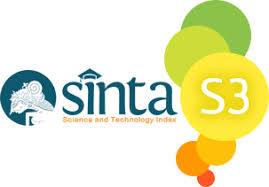The social resistance to homosexuality in McCafe Taipei's advertising
 Abstract views: 200
,
Abstract views: 200
,
 PDF downloads: 370
PDF downloads: 370
Abstract
Advertising is not a tool to sell a product. The ideology that has been carried by the advertising creator is used to resist the common ideology. Homosexuality is
still thought of as a sexual deviation and a crime. This research’s purpose is to disassemble the homosexuality in the Taipei McCafe’s advertising. This
research is using popular culture, and Barthes’s analysis. From the second order of signification (denotation, connotation, and myth) it is shown that having
a gay son is a shame condition for a parent commonly. It is a hard situation for each parent to find out that his son loves a guy too. Through this study, the
researcher also found that homosexuals are part of the family whose existence must be accepted by parents. Homosexuals in this advertisement are
considered as people who can determine their right to choose their partners and can be accepted as part of the family. In the beginning, advertising is only a
tool to sell the product, but this situation shows that becoming gay is a common thing. Homosexuality is just the sexual preference. Homosexuality it is not a
sexual deviation. So, parent nowadays, has to accept their son’s sexual preference. From this advertising, the advertisers are trying to resist the ideology about refusing the homosexuality.
References
Adihartono, W. (2021). Defining gay-friendly city as a space of resistance for Indonesian gays in Paris and Jakarta. Jurnal Simulacra Vol. 4, Issue 2 November 2021.
Chattophadyay, B. (2017). Reconstructing atmospheres: Ambient sound in film and media production. Communication and the Public 2017, Vol. 2(4) 352–364.
Cobley, P, Litza Janz. (2002) Mengenal Semiotika For Beginners. Bandung: Mizan.
Danesi, M. (2012). Pesan Tanda dan Makna. 2004. Yogyakarta: Jalasutra.
Devereux, E. (2007). Understanding the media (2nd Ed). London: The Sage Publication Ltd.
Huang, Yu Te. (2020). Lesbian, Gay, and Bisexual (LGB) Young Adults’ Relational Well-Being Before and After Taiwanese Legalization of Same-Sex Marriage: A Qualitative Study Protocol. International Journal of Qualitative Methods Volume 19, June 2020.
Ho, Min-sho. (2019). Taiwan's Road to Marriage Equality: Politics of Legalizing Same-sex Marriage. The China Quarterly , Volume 238 , June 2019.
Lobodally, A. (2018). The Commodification of Considerate in Jollibee’s Commercial Break Valentine Series: Date. International Journal of Engineering & Technology. Vol 7 No. 4. 28. 225-230
Mediboina, A. (2020). Are We Thinking Too Straight? Why We Need More LGBTQ+ Studies in India: A Perspective. Journal of Asia Medical Student Association 2020 Volume 9.
McLuhan, M. (1967). The Medium is the Massage: an Inventory of Effects. UK: Penguin Books.
Mokhtar, M, Wan Sukeri, Zulkifli Latiff. Social Media Roles in Spreading LGBT Movements in Malaysia. Asian Journal of Media and Communication Volume 3, Number 2, October 2019.
Petit, T, Alan Zakon. (1962). Journal of Marketing. 16-18.
Peluso, M. (2021). The Functional Approach, Semiotics, and Professional Discourse. Training, Language and Culture Volume 5 Issue 2, 2021, pp. 62-72.
Sanders, D. (2020). Sex and Gender Diversity in South East Asia. Journal of Southeast Asian Human Rights, Vol.4 Issue.2 December 2020 pp. 357-405.
Saskia E. Wieringa, Saskia E. (2010). Keanekaragaman Gender di Asia: Pertarungan Diskursif dan Implikasi Legal. Jurnal Gandrung Vol.1. No. 2.
Sobur, A. (2012) Analisis Teks Media: Suatu Pengantar Analisis Wacana, Analisis Semiotik, dan Analisis Framing. Yogyakarta: PT Remaja Rosdakarya.
Sobur, A. (2009) Analisis Teks Media: Suatu Pengantar Analisis Wacana, Analisis Semiotik, dan Analisis Framing. Yogyakarta: PT Remaja Rosdakarya.
Strinati, D. (2007). Popular Culture: Pengantar Menuju Teori Budaya Populer. Yogyakarta: JEJAK.
Zhang, J. (2020). Piano sound formation as a parameter of performing intonation. Problems of Interaction Between Arts Pedagogy and the Theory and Practice of Education 57.
Vera, N. (2014). Semiotika dalam Riset Komunikasi. Bogor: Ghalia Indonesia.

Jurnal Komunikasi Profesional is licensed under a Creative Commons Attribution-ShareAlike 4.0 International License.
Â
Â
1. Proposed Policy for Journals That Offer Open Access
Authors who publish with this journal agree to the following terms:
- Authors retain copyright and grant the journal right of first publication with the work simultaneously licensed under a Creative Commons Attribution License that allows others to share the work with an acknowledgment of the work's authorship and initial publication in this journal.
- Authors are able to enter into separate, additional contractual arrangements for the non-exclusive distribution of the journal's published version of the work (e.g., post it to an institutional repository or publish it in a book), with an acknowledgement of its initial publication in this journal.
- Authors are permitted and encouraged to post their work online (e.g., in institutional repositories or on their website) prior to and during the submission process, as it can lead to productive exchanges, as well as earlier and greater citation of published work (See The Effect of Open Access).
2. Proposed Policy for Journals That Offer Delayed Open Access
Authors who publish with this journal agree to the following terms:
- Authors retain copyright and grant the journal right of first publication, with the work [SPECIFY PERIOD OF TIME] after publication simultaneously licensed under a Creative Commons Attribution License that allows others to share the work with an acknowledgement of the work's authorship and initial publication in this journal.
- Authors are able to enter into separate, additional contractual arrangements for the non-exclusive distribution of the journal's published version of the work (e.g., post it to an institutional repository or publish it in a book), with an acknowledgement of its initial publication in this journal.
- Authors are permitted and encouraged to post their work online (e.g., in institutional repositories or on their website) prior to and during the submission process, as it can lead to productive exchanges, as well as earlier and greater citation of published work (See The Effect of Open Access).


